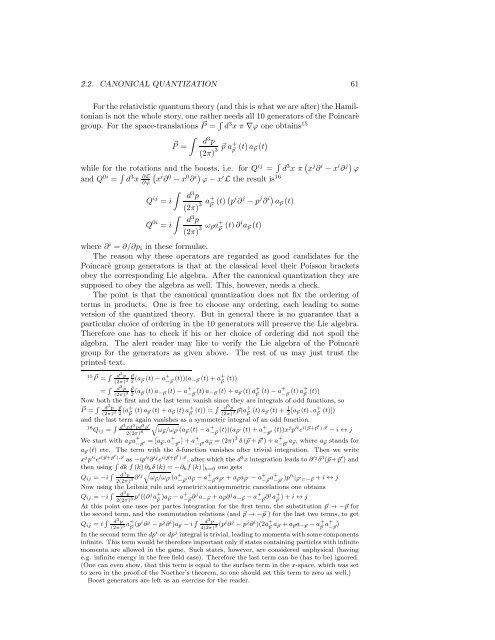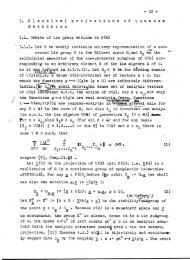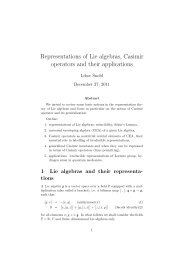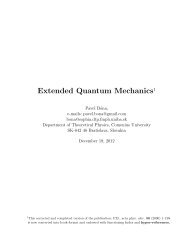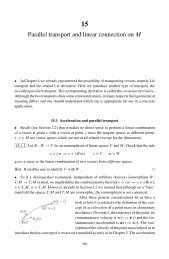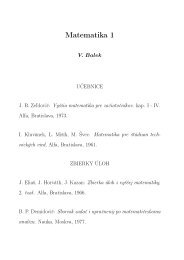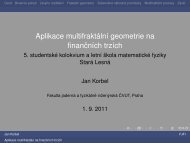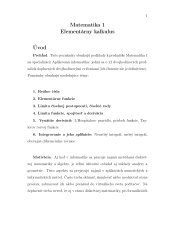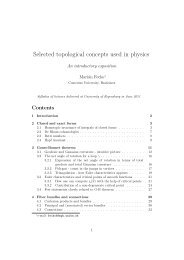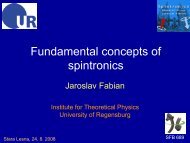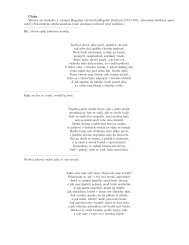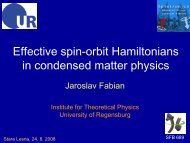Quantum Field Theory I
Quantum Field Theory I
Quantum Field Theory I
Create successful ePaper yourself
Turn your PDF publications into a flip-book with our unique Google optimized e-Paper software.
2.2. CANONICAL QUANTIZATION 61<br />
Forthe relativisticquantumtheory(and thisiswhatweareafter)theHamiltonian<br />
is not the whole story, one rather needs all 10 generators of the Poincarè<br />
group. For the space-translations P ⃗ = ∫ d 3 x π ∇ϕ one obtains 15<br />
∫<br />
⃗P =<br />
d 3 p<br />
(2π) 3 ⃗p a+ ⃗p (t)a ⃗p(t)<br />
while for the rotations and the boosts, i.e. for Q ij = ∫ d 3 x π ( x j ∂ i −x i ∂ j) ϕ<br />
and Q 0i = ∫ (<br />
d 3 x ∂L<br />
∂ ˙ϕ x i ∂ 0 −x 0 ∂ i) ϕ−x i L the result is 16<br />
∫<br />
Q ij d 3 p<br />
= i<br />
(2π) 3 a+ ⃗p (t)( p i ∂ j −p j ∂ i) a ⃗p (t)<br />
∫<br />
Q 0i = i<br />
d 3 p<br />
(2π) 3 ω ⃗pa + ⃗p (t)∂i a ⃗p (t)<br />
where ∂ i = ∂/∂p i in these formulae.<br />
The reason why these operators are regarded as good candidates for the<br />
Poincarè group generators is that at the classical level their Poisson brackets<br />
obey the corresponding Lie algebra. After the canonical quantization they are<br />
supposed to obey the algebra as well. This, however, needs a check.<br />
The point is that the canonical quantization does not fix the ordering of<br />
terms in products. One is free to choose any ordering, each leading to some<br />
version of the quantized theory. But in general there is no guarantee that a<br />
particular choice of ordering in the 10 generators will preserve the Lie algebra.<br />
Therefore one has to check if his or her choice of ordering did not spoil the<br />
algebra. The alert reader may like to verify the Lie algebra of the Poincarè<br />
group for the generators as given above. The rest of us may just trust the<br />
printed text.<br />
15⃗ P =<br />
∫ d<br />
3 p<br />
(2π) 3 ⃗p<br />
2 (a ⃗p(t)−a + −⃗p (t))(a −⃗p (t)+a + ⃗p (t))<br />
= ∫ d 3 p ⃗p<br />
(2π) 3 2 (a ⃗p (t)a −⃗p (t)−a + −⃗p (t)a −⃗p (t)+a ⃗p (t)a + ⃗p (t)−a+ −⃗p (t)a+ ⃗p (t))<br />
Now both the first and the last term vanish since they are integrals of odd functions, so<br />
⃗P = ∫ d 3 p ⃗p<br />
(2π) 3 2 (a+ ⃗p (t)a ⃗p (t)+a ⃗p (t)a + ⃗p (t)) = ∫ d 3 p<br />
(2π) 3 ⃗p(a + ⃗p (t)a ⃗p (t)+ 1 2 [a ⃗p(t),a + ⃗p (t)])<br />
and the last term again vanishes as a symmetric integral of an odd function.<br />
16 Q ij = ∫ d 3 xd 3 pd 3 p ′<br />
2(2π) 6<br />
√<br />
ω ⃗p /ω ⃗p ′(a ⃗p (t)−a + −⃗p (t))(a ⃗p ′ (t)+a+ −⃗p ′ (t))x j p ′i e i(⃗p+⃗p′ ).⃗x −i ↔ j<br />
We start with a ⃗p a + −⃗p ′ = [a ⃗p ,a + −⃗p ′ ]+a + −⃗p ′ a ⃗p = (2π) 3 δ(⃗p+ ⃗p ′ )+a + −⃗p ′ a ⃗p , where a ⃗p stands for<br />
a ⃗p (t) etc. The term with the δ-function vanishes after trivial integration. Then we write<br />
x j p ′i e i(⃗p+⃗p′ ).⃗x as −ip ′i ∂ ′j e i(⃗p+⃗p′ ).⃗x , after which the d 3 x integration leads to ∂ ′j δ 3 (⃗p+⃗p ′ ) and<br />
then using ∫ dk f (k)∂ k δ(k) = −∂ k f (k)| k=0 one gets<br />
Q ij = −i ∫ √<br />
d 3 p<br />
2(2π) 3 ∂ ′j ω ⃗p /ω ⃗p ′(a + −⃗p ′ a ⃗p −a + −⃗p a ⃗p ′ +a ⃗pa ⃗p ′ −a + −⃗p a+ −⃗p ′ )p ′i | ⃗p ′ =−⃗p +i ↔ j<br />
Now using the Leibniz rule and symetric×antisymmetric cancelations one obtains<br />
Q ij = −i ∫ d 3 p<br />
2(2π) 3 p i ((∂ j a + ⃗p )a ⃗p −a + −⃗p ∂j a −⃗p +a ⃗p ∂ j a −⃗p −a + −⃗p ∂j a + ⃗p )+i ↔ j<br />
At this point one uses per partes integration for the first term, the substitution ⃗p → −⃗p for<br />
the second term, and the commutation relations (and ⃗p → −⃗p ) for the last two terms, to get<br />
Q ij = i ∫ d 3 p<br />
(2π) 3 a + ⃗p (pi ∂ j −p j ∂ i )a ⃗p −i ∫ d 3 p<br />
4(2π) 3 (p i ∂ j −p j ∂ i )(2a + ⃗p a ⃗p +a ⃗p a −⃗p −a + ⃗p a+ −⃗p )<br />
In the second term the dp i or dp j integral is trivial, leading to momenta with some components<br />
infinite. Thisterm wouldbe therefore importantonly ifstates containing particleswith infinite<br />
momenta are allowed in the game. Such states, however, are considered unphysical (having<br />
e.g. infinite energy in the free field case). Therefore the last term can be (has to be) ignored.<br />
(One can even show, that this term is equal to the surface term in the x-space, which was set<br />
to zero in the proof of the Noether’s theorem, so one should set this term to zero as well.)<br />
Boost generators are left as an exercise for the reader.


